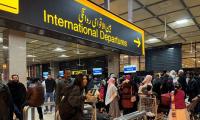Schools and universities remained closed at the height of the Covid pandemic while the country debated and dissected issues surrounding online education in major cities, small towns, and rural areas.
The accounts and experiences laid bare the massive digital divide between parts of the country. Most households do not own a single computer. Many students fortunate enough to participate in interactive online classes had to do it through tiny smartphone screens; desktop and laptop computers were only available in a small fraction of households. Not surprisingly, outside the well-connected islands of major cities, broadband connectivity necessary for live video is virtually non-existent.
About a year ago I was traveling in Khyber Pakhtunkhwa’s merged districts, formerly known as Fata, where I had the opportunity to talk to an FSs pre-medical student. He dreamed of being accepted into a medical college. I asked him how he imagined that possible, given that all educational institutions were operating online due to Covid-19. He replied he would study online if needed, like so many other students in the country were at the time. The people of ex-Fata and other remote communities across the country want the same opportunities as residents of the gated communities of Islamabad, Lahore and Karachi.
Teledensity (measured in percent) is the number of connections per 100 individuals living in an area. According to the November 2021 data of the Pakistan Telecommunication Authority (PTA), Pakistan’s teledensity of wireless local loop and fiber local loop internet connectivity currently stands at a meager 1.14 percent. The number of broadband subscribers of all technologies (including DSL, fiber / wireless local loop, WiMax and all manner of cellular technologies) add up to a healthy 110 million. Last year, the Word Bank conducted a survey of 33,500 schools to assess available options for internet connectivity in their localities. Only 9,800 – less than a third – have an optical fiber node in the area. Approximately 2,200 are in areas that do not even get a cellphone signal for voice calls.
Despite this seemingly high number of broadband subscribers, internet connectivity and devices for children, teachers and schools were bottlenecks to maintaining continuity of classes across most schools in the country. And 4G / LTE connectivity capable of streaming video remains confined to major cities. The HEC tried to negotiate concessional data packages for college and university students who had moved out of dorms and gone back to their homes, dispersing across the country.
Government departments urged telcos to expand service coverage, but that is an expensive undertaking. It requires new cell towers to be set up and maintained, each of which adds coverage of only a few square kilometers. That tower then must be connected to the service provider’s network by means of a hardline or other wireless connection. If those costs cannot be recouped from the additional revenue the expanded coverage will bring within a reasonable time, the expansion becomes hard to justify. The dearth of subscribers willing to pay for data in small towns and rural areas means there is no business case for expanding 4G connectivity beyond where it stands.
Last week a team from SpaceX made a presentation to the Ministry of Federal Education and Professional Training (MoFEPT) to discuss what Starlink service [when brought to Pakistan] would mean for education. SpaceX, founded by Tesla founder Elon Musk in California in 2002, has become known the world over for spectacular footage of accurate return landings of its reusable Falcon 9 and Falcon Heavy rockets and, more recently, test flights of Starship currently under development to take relatively large groups of people to Mars.
One of SpaceX’s ventures is Starlink, a service that will provide broadband satellite internet connectivity everywhere by means of a constellation of 12,000 satellites circumnavigating the globe in low Earth orbit (LEO) at an altitude of 550 km every 90-110 minutes. At the moment, approximately 1,500 satellites are deployed and in operation. Subscribers get a router for their home that is wired to a small parabolic antenna placed outdoors that tracks Starlink satellites overhead for incoming and outgoing traffic. Starlink’s satellites bounce traffic down to a Starlink gateway, which is connected to the country’s Internet backbone. The big difference is, depending on population density and usage, a single Starlink gateway is capable of serving thousands of square kilometers. The US is currently served by only 53 Starlink gateways, which provide residential internet connectivity at download speeds between 50 and 400 Mbps even in remote areas at about $99 a month.
Why should Starlink coming to Pakistan excite us? It should excite us because of all technologies on the horizon (5G and early sketches of 6G) Starlink’s tech looks like the best bet to close the digital divide for rural, remote and otherwise under provisioned communities. Starlink provides incoming and outgoing internet traffic via satellite – which means it does not require digging and laying cables all the way to customer premises (a major expense) or deploying cell towers every few kilometers.
SpaceX is currently working with departments in Pakistan to understand and meet regulatory requirements and the challenges in developing the necessary ground infrastructure. If successful, Starlink could fill a big chunk of the connectivity gap that existing service providers that use DSL, FTTH, WiMax and cellular technologies are unable to fill. Admittedly, with a per-capita GDP shy of $1200 (Word Bank data 2020), if similarly priced, a $99 per month internet connection is still far from affordable for most middle-class and rural households in Pakistan, but it brings portable (not mobile) broadband connectivity where it has previously not been available at any price.
While that price point is too high for most households in Pakistan, it may become feasible to connect schools in remote locations, which would undoubtedly be a major leap forward. If Starlink is able to offer lower prices, at a lower data rate perhaps, that could put it within reach of the general population. It fits well into the MoFEPT agenda that is pushing for the expansion of internet coverage in service of its distance learning wing.
A few days ago, an op-ed in this paper announced the launch of an Android app as a new mechanism for the registration of beneficiaries of school stipends under the Ehsaas programme. That is a commendable step towards online public service delivery. However, it presupposes that beneficiaries have a smartphone and, more importantly, internet access. Many beneficiaries of this programme are located in far-flung areas. In the recent past, another programme tried to make school voucher payments to beneficiaries in remote areas using mobile wallet services. Unfortunately, lack of internet service in their locations meant that for two years that programme could never get off the ground.
As long as internet coverage remains as concentrated as it is now, remote communities will be the ones to benefit least from e-government services. Connectivity will aid not just education, but health, commerce and agricultural sectors, all part and parcel of the new National Security Policy that puts the economy at the center. If SpaceX’s Starlink makes it into Pakistan and can offer affordable connectivity for everyone, it will be a major boost to every sector.
A few hours after I talked to the FSc student in ex-Fata, I found myself in the office of the local deputy commissioner talking to a military officer posted in the area also visiting the office. We got to talking about the poor level of connectivity and I was given the same arguments against ubiquitous internet access we are used to hearing – that opening up internet access in the area will also give access to terrorists fomenting trouble.
I will leave it to others to argue in favour of denying already disadvantaged communities the right to communicate via the internet. However, I will say this much: We are not the only country on Earth that is fighting terror in the age of the internet. Others have too, and without denying internet access to entire communities wholesale. In fact, in some instances it has been culprits’ internet use that led to their identification and capture. Furthermore, weigh the optics of such a policy. We have seen how the Delhi regime’s fascist policy of a blanket internet ban on the people of Indian Illegally Occupied Jammu & Kashmir has played out on the world stage.
In the 21st century I cannot imagine any kind of development or opportunities coming to an area that is withheld access to the internet. Lack of opportunities and second-rate education will encourage migration to other areas of the country, hollowing out local communities even further. I hope better sense prevails and for Starlink to beam us up!
The writer (she/her) is the technical adviser to the MoFEPT. Views are her own.
A common thing that happens in Pakistan is tendency for young children to go to bed very late, even on school night
Pakistan climate strategy risks being undermined by incoherent policy framework that fails to integrate climate action
Starmer comes up with strong reaction on Monday, condemning Musk’s increasingly erratic attacks on UK govt
Prolonged slowdown erodes credibility of Pakistan’s IT sector on the global stage
Role of UN in peacekeeping must also be strengthened to ensure stability in region
America’s economic and technological prowess is rooted in its willingness to embrace risk, foster innovation, and...







